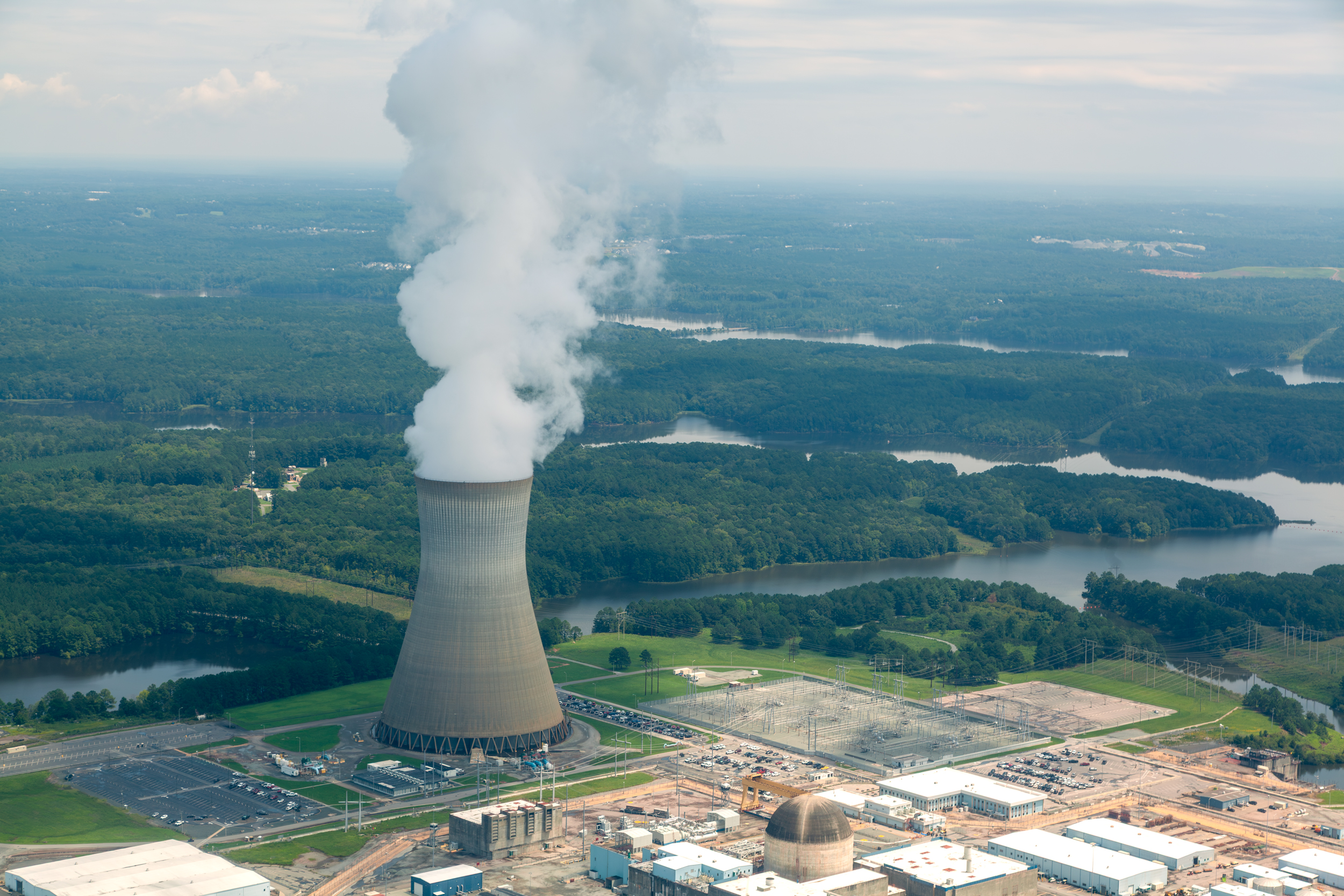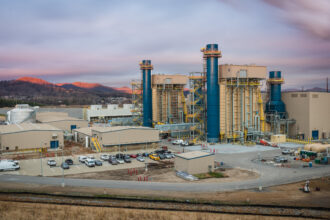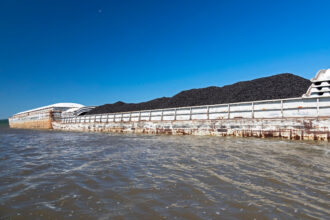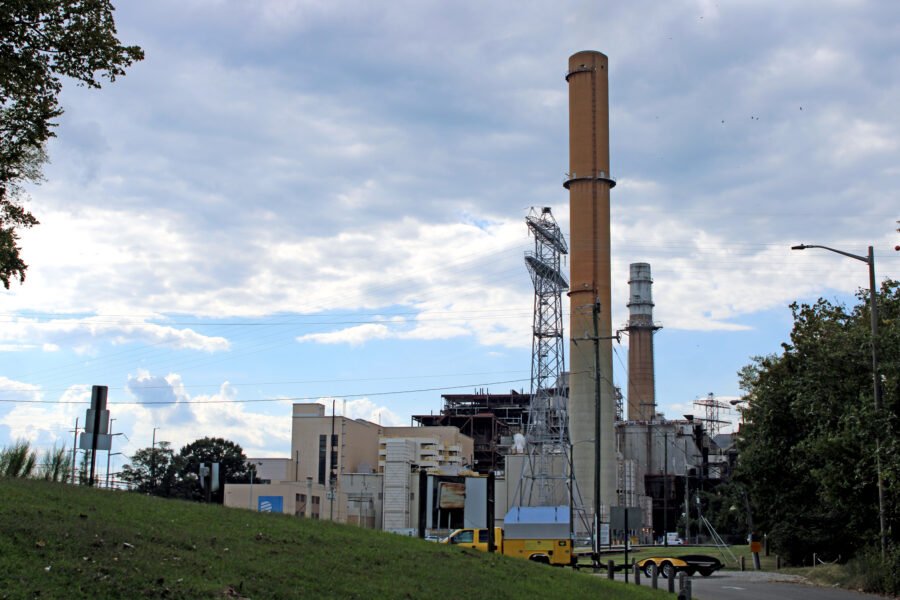Duke Energy plans to burn coal for two to four years longer than previously estimated, which will result in millions of tons in additional greenhouse gases over the next decade when combined with other proposed changes to the utility’s fuel mix.
The utility would significantly increase battery storage—by 56 percent—but also deploy fewer renewables.
The details are laid out in more than 100 pages of the utility’s biennial Carbon Plan, released Oct. 1 and submitted to the North Carolina Utilities Commission.
Duke cited the state’s growing energy demand, driven by data centers and large manufacturers, coupled with the Trump administration’s fossil-fuel friendly energy policy as reasons for the changes. This includes the rollback of federal air regulations, increased support for the coal industry and the end of renewable power subsidies.
State policy, too, shaped the plan. Senate Bill 266, now law after the state legislature in late July overrode Gov. Josh Stein’s veto, allowed Duke to eliminate its interim goal of a 70 percent reduction in carbon emissions by 2035. Instead, the utility is only subject to a goal of net zero by 2050.
Under its previous plan, Duke projected it would shutter its remaining coal-fired power plants no later than 2035. Last year the utility retired the Allen Steam Station on Lake Wylie, where the first battery storage goes online next month.
But unfettered by the interim carbon reduction goal, several of those retirement dates have been extended to the mid-to-late 2030s, depending on the plant.
Belews Creek, in Stokes County, would burn coal as late as 2040, four years longer than planned, when Duke projects a small nuclear reactor could come online.
Belews Creek emitted 5.5 million tons of carbon dioxide equivalent in 2022, according to data from the U.S. Environmental Protection Agency. Carbon dioxide equivalent is a unit of measurement to evaluate the impact of different greenhouse gases.
Some units at the Cliffside and Marshall plants would burn coal for an extra two years, until 2033 and 2034.
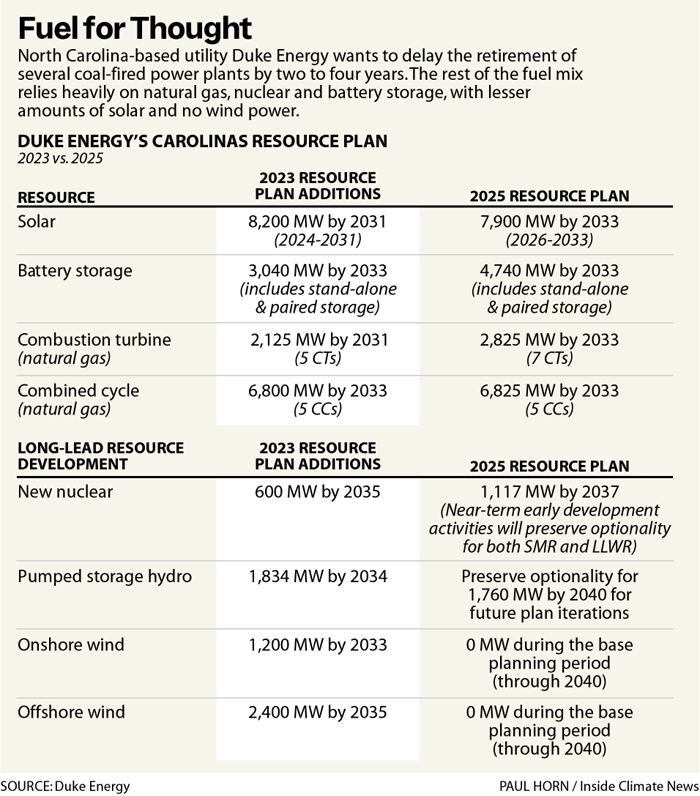
These plants, and several others, can burn coal and natural gas, further increasing emissions of potent planet-warming gases, carbon dioxide and methane.
“We continue making progress on coal retirements while balancing regulatory approvals and increased load growth,” Duke Energy spokesman Bill Norton said. “Regulators have made clear that replacement generation must be online and serving customers prior to further coal plant retirements.”
CleanAIRE NC, a nonprofit environmental group based in Charlotte, issued a statement expressing “serious concerns about Duke Energy’s proposed plan, which continues to prioritize fossil fuel expansion, delays coal retirement, and lacks meaningful engagement with the communities most vulnerable to environmental and economic harm.”
Duke acknowledges that coal is risky. It is more expensive and considerably more polluting than natural gas. Nationwide, mining has declined, both in the number of workers and the amount of coal produced.
Even though the Trump administration is opening public lands in the western U.S. for coal mining, Duke has outfitted its plants to burn low-sulfur coal sourced from Central Appalachia, where production is waning.
Norton said Duke “continues to plan for an orderly retirement of coal as a necessary means to protect reliability in light of the increasing challenges in the operation of these end-of-life assets.”
The utility plans to continue to expand its natural gas fleet, which requires more than 100 miles of new pipeline in North Carolina. The pipelines, compressor stations and the plants themselves leak and emit tons of methane, a greenhouse gas that, while shorter-lived in the atmosphere, is 86 times more potent at warming the planet than carbon dioxide over 20 years.
Meech Carter, clean energy campaigns director for the North Carolina League of Conservation Voters Foundation, said gas infrastructure additions are “driven by the expansion of data centers and artificial intelligence, allowing big technology companies and Duke Energy to profit at ratepayers’ expense.”
The extent of data centers’ effects on energy demand remains unclear. Analysts with Duke University’s Nicholas Institute for Energy, Environment & Sustainability posit that targeted, timed reductions in power demand could ease the strain on the grid without massive power-plant buildouts.
Duke has reined in its plans for solar power, compared to the previous Carbon Plan. It had originally projected to add 8,200 megawatts by 2031; the new proposal reduces the megawattage to 7,900 and extends the date to 2033.
The utility previously projected it would add 3,600 megawatts of onshore and offshore wind within the next decade. But the new energy mix eliminates wind power until at least 2040, reflecting President Donald Trump’s rejection of that energy source.
The Trump administration recently canceled $679 million for offshore wind projects. None were in North Carolina, but a nearby wind logistics port in Norfolk, Virginia, lost more than $39 million in federal funding.
Duke also plans to request permission from the Nuclear Regulatory Commission to increase power and extend licenses for existing nuclear plants.
After a lengthy public hearing process, the state utilities commission must issue an order on the plan—approving it as is or requiring amendments—by Dec. 31, 2026.
About This Story
Perhaps you noticed: This story, like all the news we publish, is free to read. That’s because Inside Climate News is a 501c3 nonprofit organization. We do not charge a subscription fee, lock our news behind a paywall, or clutter our website with ads. We make our news on climate and the environment freely available to you and anyone who wants it.
That’s not all. We also share our news for free with scores of other media organizations around the country. Many of them can’t afford to do environmental journalism of their own. We’ve built bureaus from coast to coast to report local stories, collaborate with local newsrooms and co-publish articles so that this vital work is shared as widely as possible.
Two of us launched ICN in 2007. Six years later we earned a Pulitzer Prize for National Reporting, and now we run the oldest and largest dedicated climate newsroom in the nation. We tell the story in all its complexity. We hold polluters accountable. We expose environmental injustice. We debunk misinformation. We scrutinize solutions and inspire action.
Donations from readers like you fund every aspect of what we do. If you don’t already, will you support our ongoing work, our reporting on the biggest crisis facing our planet, and help us reach even more readers in more places?
Please take a moment to make a tax-deductible donation. Every one of them makes a difference.
Thank you,


